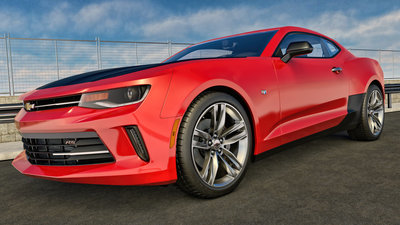2016 Chevrolet Camaro RS Coupe Review by John Heilig +VIDEO
THE AUTO PAGE
By John Heilig
Senior Editor
Mid-Atlantic
Bureau
The Auto Channel
REVIEWED MODEL: 2016 Chevrolet Camaro
RS Coupe
ENGINE: 2.0-liter turbocharged I-4
TRANSMISSION: 8-speed
automatic with paddle shifters
HORSEPOWER/TORQUE; 275 hp @ 5,600
rpm/295 lb.-ft. @ 3,000 rpm
WHEELBASE: 110.7 in.
LENGTH X WIDTH X
HEIGHT: 188.3 x 74.7 x 53.1 in.
TIRES: P245/40R20
CARGO: 9.0 cu.ft.
ECONOMY: 22 mpg city/31 omg highway/21.4 mpg test
FUEL TANK: N/A
CURB WEIGHT: 3,339 lbs.
COMPETITIVE CLASS: Ford Mustang, Dodge
Challenger, Lexus RC
STIC KER: $38,520 (includes $995 delivery, $7,725
options)
BOTTOM LINE: While it may not be the hairy-legged SS version
of the Chevrolet Camaro, the RS is most likely the version that most people
will buy. It has very good performance that one would want and expect from
a Camaro, with exciting styling to complement it.
In an interview with soon-to-be-retired GM Vice President of Global Design Ed Wilbur, he told me that he appreciates the finer points of design as much as he does a striking overall car. For example, he pointed out that a well-done interior drawer design or a good interior is important to him.
I must confess to an equal appreciation of interior design. After all, the driver and passengers spend all of their time inside the car, and that’s what they see.
The Chevrolet Camaro’s interior ranks with the best of them. For example, there is a Zagato-like “double bubble” over the instrument pods that mimics then exterior roof design. In addition, interior lighting, which has become a Chevy staple of late, highlights interior surfaces. There are sweeps on both doors and a curve around the infotainment screen. These are blue in daylight, red at night.
The red fits. The exterior is clad in “Red Hot” paint; the seats in “Adrenaline Red” and white, with red inserts on the doors. The car looks as if it was designed as a whole, rather than put together with assorted bits and pieces out of the parts bin.
Space is at a premium in the Camaro, and the design of the center stack lets you appreciate how well the designers have made use of what they had. The center stack-mounted air vents also have temperature controls, so that you can adjust the direction of the air and its temperature with one movement.
Which brings us to what isn’t seen. Under the hood is a 2.0-liter turbocharged four. This isn’t the potent big V8 you’ll find in the top-of-the-line that has enough power to make the rear end slide out of control every time you tromp on the gas pedal. While the turbo four has enough power (275 horsepower) to get you in trouble (especially with the styling and Red Hot paint), it is really more sedated. Chevrolet boasts that the four is as powerful as any small block V8 offered from 1971-1995. Paddle shifters for the 8-speed automatic transmission allow you to extract maximum performance from the engine, but just driving along in pure automatic isn’t a slouch. Acceleration is very good and is accompanied with enough exhaust volume to still let you know you’re in a Camaro.
There are three driver modes - Tour, Sport and Snow/Ice. We kept it in Sport most of the time, which may have had a deleterious effect on fuel economy.
Ride quality is very good. Twenty-inch wheels don’t hurt. Cornering capability is very good, yet the suspension, while firm, isn’t harsh. Camaro can be a very hot car, but it can also be a good compact car for touring.
Instruments are clear with two major gauges for tachometer and speedometer and four accessory gauges connecting the two; oil pressure, water temperature, fuel level and turbo boost. The infotainment screen is fairly standard, but arrayed across the bottom are HVAC controls (heated seats, temperature, air direction, fan speed and defrosters). It is a compact. clear design. The busy flat-bottomed wheel has audio, cruise controls and paddle shifters. All the interior controls are within the driver’s reach so he/she can have full control.
All is not perfect in Camaro-land, however. The view out the rear window from the rear view mirror is narrow, due to the car’s low roofline and rear seat backs. Access to those rear seats is difficult, and rear legroom is tight. The Camaro is a true four-seater (2+2?) because of a console between the two rear seats.
The seat backs fold to increase cargo capacity from a small 9.0 cubic feet, but there is a “frame” around the connection between the trunk and rear seats that restricts in some ways the amount that can be shared. The center console/arm rest is also small, and is shared with a pair of cupholders. Inside the console are USB and AUX connections.
The Gen 6 Chevrolet Camaro is a delight, though. I especially liked the Zagato-like “double bubble” roof styling and the clean, dramatic interior. The more practical engine made driving the Camaro a pleasure under all circumstances.
(c) 2016 The Auto Page Syndicate
The Most In-Depth Independent Chevrolet Research Data Anywhere!



